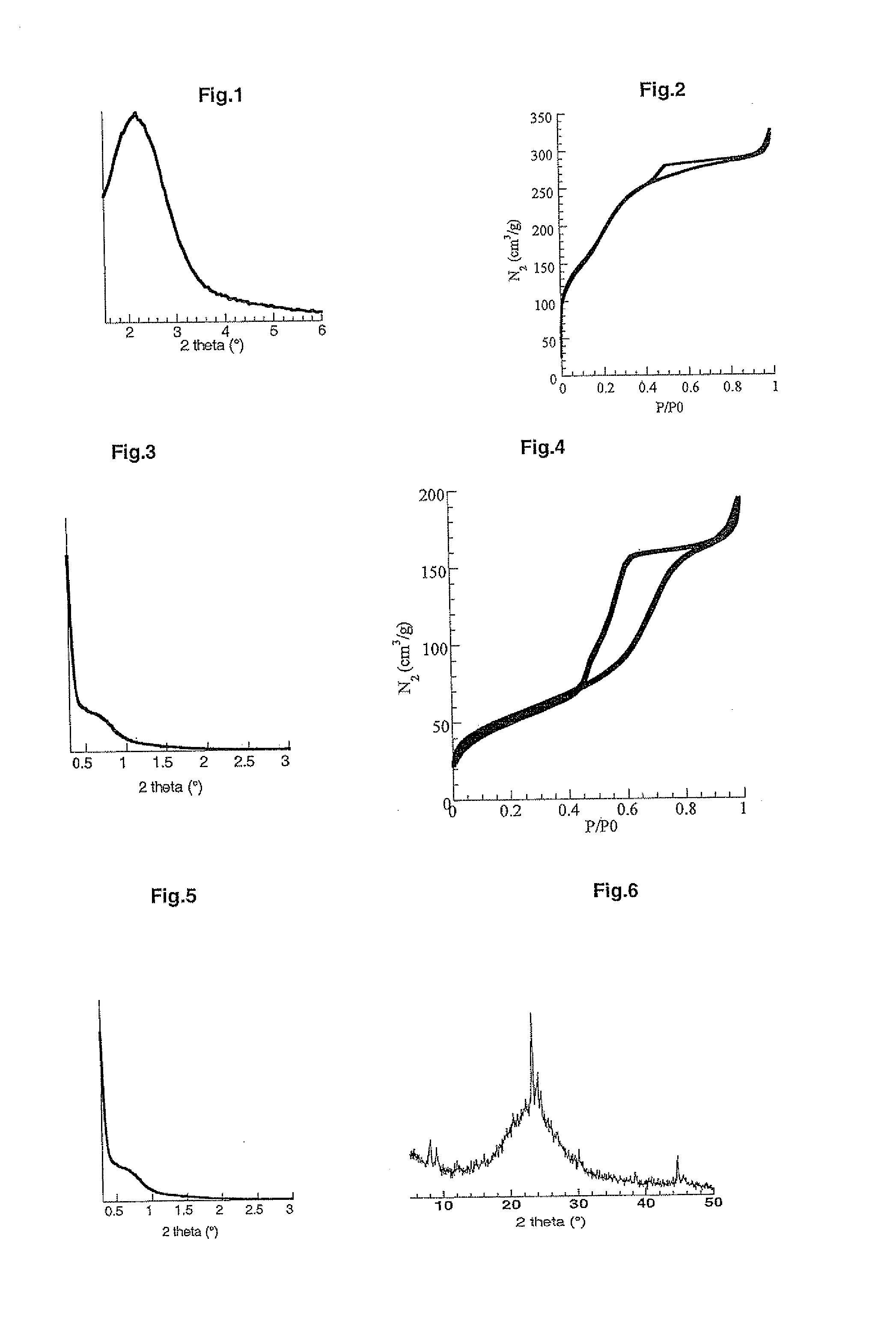Mesostructured material with a high aluminium content
a technology of mesostructured materials and aluminum content, which is applied in the direction of crystalline aluminosilicate zeolites, chemistry apparatus and processes, physical/chemical process catalysts, etc., can solve the problems of delicate implementation of techniques, and achieve the effect of high aluminum content, easy development of mesostructured materials, and advantageous acido-basicity properties
- Summary
- Abstract
- Description
- Claims
- Application Information
AI Technical Summary
Benefits of technology
Problems solved by technology
Method used
Image
Examples
example 2 (
INVENTION)
Preparation of a Mesostructured Aluminosilicate Material with a High Aluminum Content of an Si / Al Molar Ratio=0.9.
[0050]2.65 g of aluminum trichloride is added to a solution that contains 30 g of ethanol, 13.8 ml of water, 0.036 ml of HCl, and 1.4 g of surfactant P123. The overall structure is stirred at ambient temperature until the aluminum precursor dissolves completely. 2 g of tetraethyl orthosilicate (TEOS) is then treated. After stirring for 18 hours at ambient temperature, the overall structure is sent into the spraying chamber of the aerosol generator, and the solution is sprayed in the form of fine droplets under the action of the carrier gas (dry air) that is introduced under pressure (P=1.5 bar). The droplets are dried according to the operating procedure described in the specification of the invention above. The temperature of the drying furnace is set at 350° C. The collected powder is then calcined in air for 5 hours at T=550° C. The solid is characterized by...
example 3 (
INVENTION)
Preparation of a Mesostructured Aluminosilicate Material with a High Aluminum Content Comprising ZSM-5 (MFI)-Type Zeolite Nanocrystals (Molar Si / Al=100, 10% by Weight of the Final Material) Trapped in a Mesostructured Aluminosilicate Matrix (Molar Si / Al=0.9).
[0051]0.14 g of tri-sec-aluminum butoxide is added to a solution that contains 3.5 ml of tetrapropyl ammonium hydroxide (TPAOH), 0.01 g of NaOH soda, and 4.3 ml of water. After aluminum alkoxide is dissolved, 6 g of tetraethylorthosilicate (TEOS) is added. The solution is stirred at ambient temperature for 5 hours then is autoclaved at T=95° C. for 12 hours. The white solution that is obtained contains 135 nm ZSM-5 nanocrystals. This solution is centrifuged at 20,000 rpm for 30 minutes. The solid is redispersed in the water and then centrifuged again at 20,000 rpm for 30 minutes. This washing is carried out twice. The nanocrystals form a gel that is dried in the oven for one night at 60° C. 0.461 mg of these crystals i...
PUM
| Property | Measurement | Unit |
|---|---|---|
| diameter | aaaaa | aaaaa |
| thickness | aaaaa | aaaaa |
| thickness | aaaaa | aaaaa |
Abstract
Description
Claims
Application Information
 Login to View More
Login to View More - R&D
- Intellectual Property
- Life Sciences
- Materials
- Tech Scout
- Unparalleled Data Quality
- Higher Quality Content
- 60% Fewer Hallucinations
Browse by: Latest US Patents, China's latest patents, Technical Efficacy Thesaurus, Application Domain, Technology Topic, Popular Technical Reports.
© 2025 PatSnap. All rights reserved.Legal|Privacy policy|Modern Slavery Act Transparency Statement|Sitemap|About US| Contact US: help@patsnap.com


